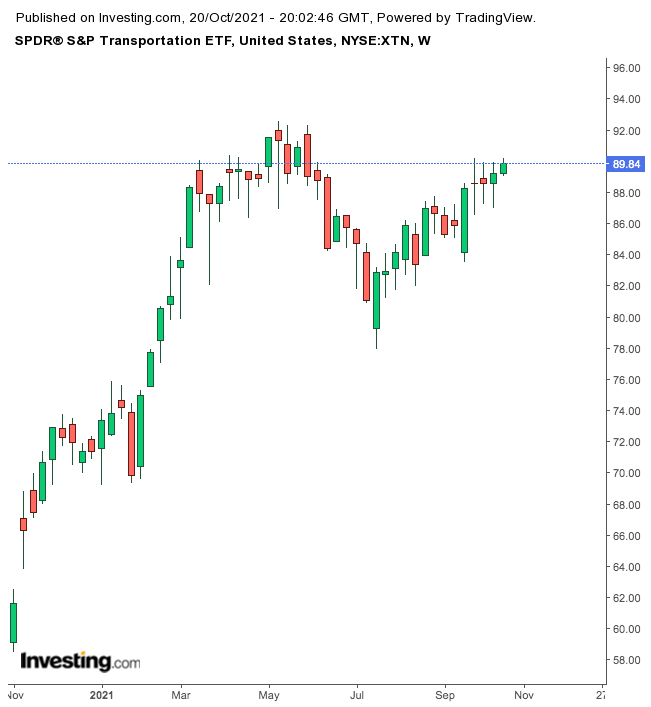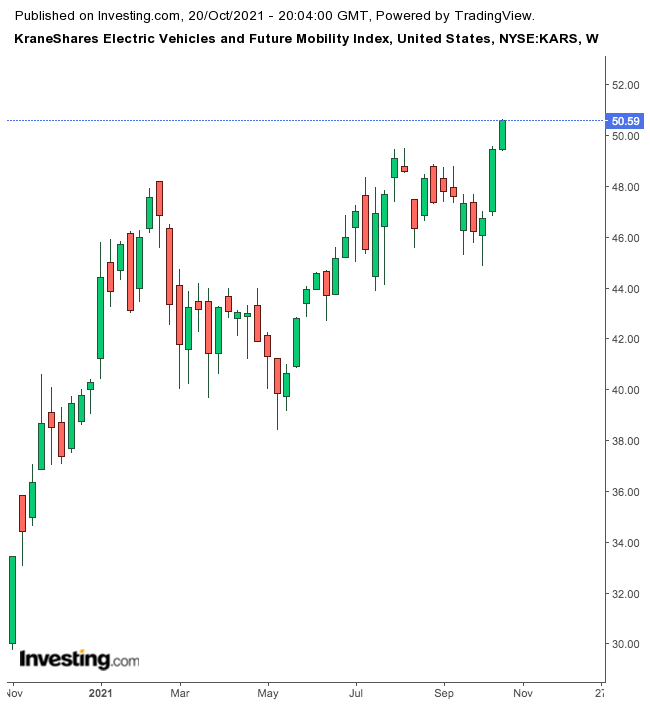The early days of the coronavirus pandemic dented many industries, including the transportation sector, which saw multi-year lows in the spring of 2020.
But, the stock market rally since then has meant record highs for many transportation shares and exchange-traded funds (ETFs).
For instance, the Dow Jones Transportation Average hit an all-time high in May 2021. However, more recently the segment has come under pressure and the index has shed about 5% of its value.
However, it is still up about 22.5% so far this year compared to the S&P 500 which has returned 20.5%.
The transport sector, which includes “freight transportation by road, rail, air, marine and pipeline, but also passenger transportation,” is a key component of the economy.
According to the U.S. Bureau of Transportation Statistics, the COVID-19 pandemic caused household spending on transportation to drop by nearly 14% in 2020.
The report stated:
“As Americans drove fewer commutes and took fewer trips, the average U.S. household spent $9,645 moving around in their everyday lives in 2020, dropping from $10,960 in 2019.”
The European Union and the UK have also reported similar spending declines. Nonetheless, the global transportation services market was expected to reach US$7.8 trillion by 2027, up from $6.2 trillion in 2020, according to one report.
Therefore, today we introduce two ETFs that could appeal to readers researching the industry further.
1. SPDR S&P Transportation ETF
Current Price: $89.87
52-Week Range: $57.36 - $92.58
Dividend Yield: 1.17%
Expense Ratio: 0.35% per year
The SPDR® S&P Transportation ETF (NYSE:XTN) is an equal-weight fund that currently gives access to 48 U.S.-based companies in the transportation sector.

XTN, which tracks the returns of the S&P Transportation Select Industry, started trading in January 2011. In terms of sub-sectors, trucking gets the biggest share, with 37.81%, followed by airlines (25.29%), air freight and logistics (19.74%), railroads (9.27%) and marine companies (7.86%). The top 10 holdings comprise about a quarter of the net assets of $579.4 million.
Among the leading names in the roster are auto rental company Avis Budget (NASDAQ:CAR), freight transportation and logistics group ArcBest (NASDAQ:ARCB), ride-sharing platform Uber Technologies (NYSE:UBER), industrial products transporter Norfolk Southern (NYSE:NSC) and airline group SkyWest (NASDAQ:SKYW).
The fund is up 24.8% this year and 44.5% in the past 12 months. It saw a record high in May. P/E and P/B ratios stand at 13.83x and 2.64x. The current earnings season could mean higher volatility levels in many of the names that make up XTN. A potential decline toward $87 would improve the margin of safety.
2. KraneShares Electric Vehicles and Future Mobility Index ETF
Current Price: $50.53
52-Week Range: $29.10 - $50.66
Dividend Yield: 011%
Expense Ratio: 0.70% per year
Recent metrics suggest sales of electric vehicles (EVs) have rocketed in China, the U.S. and Europe with EVs accounting for 26% of all new car sales globally.
The KraneShares Electric Vehicles and Future Mobility Index (NYSE:KARS) invests in businesses that are at the forefront of new technologies in mobility. These companies might be electric vehicle and battery manufacturers, leading names in autonomous driving, shared-mobility platforms, or those driving the transition to alternative resources. Some of these firms are also developing technologies for vehicle connectivity, like the Internet of Vehicles.

KARS, which tracks the performance of the Bloomberg Electric Vehicles Index, currently has 69 holdings. The top 10 names make up over half of net assets of $283.3 million. In terms of sectors, we see consumer discretionary (44.75%), followed by materials (19.03%), information technology (17.52%) and industrial (16.63%).
Leading holdings in the fund are EV heavyweight Tesla (NASDAQ:TSLA), Germany-based auto giant Daimler (OTC:DDAIF) , chip-maker Analog Devices (NASDAQ:ADI), Chinese battery group Contemporary Amperex Technology (SZ:300750) and legacy automaker General Motors (NYSE:GM).
KARS is up 24.6% so far this year and 61.2% in the past 52 weeks. The fund hit a record high on Oct. 19. In the coming days, many of the names in the ETF will report quarterly metrics. Given the recent increase in price, interested readers might want to wait for a potential pullback toward the $48 level.
